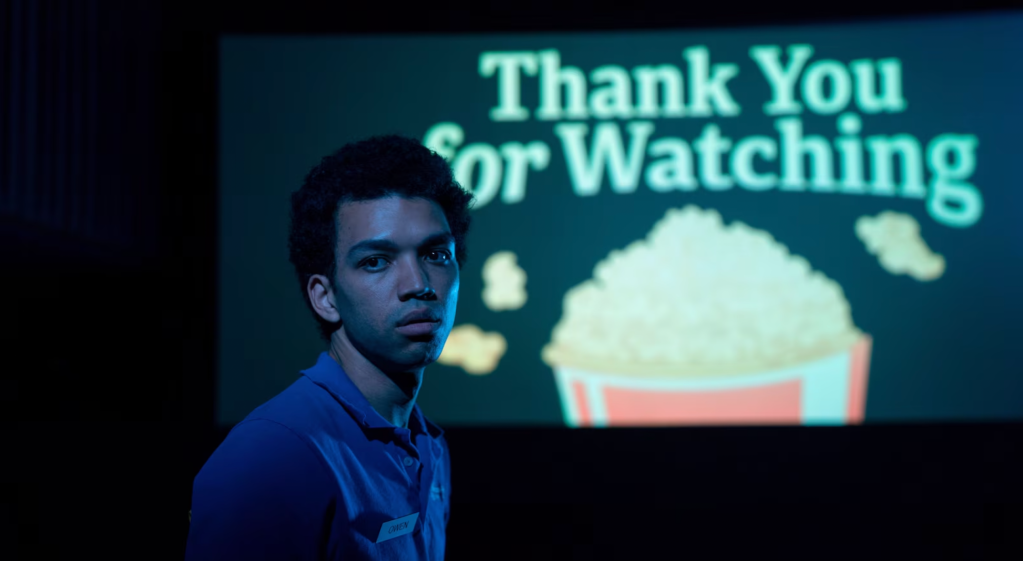Unpacking why I Saw The TV Glow resonates with trans audiences, from beginning to end

Justice Smith and Bridgette Lundy-Paine in Jane Schoenbrun’s horror film I Saw The TV Glow. (A24)
Amid a slew of new LGBTQ+ films, Jane Schoenbrun’s psychological horror drama I Saw The TV Glow has earned praise for standing out from the crowd thanks to its powerful trans allegory.
The second feature-length film from Jane Schoenbrun – who is trans and non-binary, and uses they/them pronouns – stars queer Detective Pikachu actor Justice Smith as Owen, a reserved teenager and social outcast.
He’s introduced to “The Pink Opaque”, a horror soap opera TV show, via his friend and fellow outcast Maddy (non-binary, Atypical star Brigette Lundy-Paine). The pair’s friendship, and Owen’s sense of self-identity, hinges on the show, but when the show is cancelled and Maddy disappears, Owen’s “view of reality begins to crack”.
Despite achieving rave reviews from critics, there appears to be a divide in how I Saw The TV Glow is being received by its trans viewers and its cis audiences, with the latter seemingly unable to pick up why the film is being seen as explicitly queer.
It’s a fact Schoenbrun has noticed themself, and is an element of the film they are “most proud of”.
The film’s beginning is a trans metaphor
Despite some confusion from cis viewers, who have incorrectly dubbed I Saw The TV Glow as an ode to ‘90s nostalgia, the film literally begins with a trans metaphor.
In the scene, Owen as a child (played by Ian Foreman) looks lost and perturbed as he wanders about underneath a school parachute. The parachute is pink, white, blue, and purple – a sort of blend between the trans and bisexual Pride flags.
“I’m not sure of the director/set designer’s intent,” wrote one LGBTQ+ viewers after watching. “But I definitely view it as a fluidity of trans/bi love flag which I honestly love.”
Owen uses “The Pink Opaque” as a means of escape
Owen becomes obsessed with The Pink Opaque and its Buffy The Vampire Slayer-style female characters, finding euphoria in dressing as his favourite character and losing himself in the reality which isn’t his own.
As one trans writer put it: “Many of us fantasise about some way we can turn into a character from the media that brings us some euphoria, or to leave our mundane existence and go on the fantastical journey that transition seems like.”
Schoenbrun previously told The Verge that they were a big fan of Buffy growing up, but felt they had to hide it.
“I found Buffy at the end of season 1, and throughout my adolescence, the show was this really important thing for me that I couldn’t really talk to other people about or express how much I loved because I was scared of getting made fun of,” they explained.
“There’s this line in I Saw the TV Glow that looms large: ‘isn’t that a show for girls?’ And I was very conscious of that kind of judgment growing up. It kind of created shame within me about how obsessed with Buffy I was.”
The film’s time jump symbolises the non-linear journey to self-acceptance
Towards the film’s end, there is a time jump of 20 years and Owen is dissatisfied, working a dull job at an arcade, with a wife and kids at home. After a breakdown at work, Owen heads to the bathroom to get himself together, and then apologises to his colleagues and customers. For creator Jane Schoenbrun, this is “truthful” representation of what so many trans people experience.

“To get Owen to a place of true self-love and self-acceptance would take at least another movie. I knew that I wanted it to be really honest to the fact that just because you’ve now finally seen yourself clearly doesn’t mean that the half a lifetime of damage that repression has instilled in you is going to go away,” they told USA Today.
The box cutter scene at the film’s end symbolises gender dysphoria
While in the bathroom following his outburst, Owen uses a box cutter to cut into his chest. Inside, is TV static. According to Schoenburn, it represents the “subliminal… wrongness humming quietly in the background” that they experienced with dysphoria.
“The idea of being seemingly OK on the outside, but on the inside being this hollowed-out sack of static, felt like a nice way to talk about the pre-transition mindset.”
The end also leaves the Owen’s journey open
Many depictions of trans people on-screen begin or end with a grandiose coming out scene, or some sort of positive resolution. For Schoenburn, it felt more authentic to leave Owen’s future open and undefined, as is the experience of many trans people. Plus, it also leaves the door open for an I Saw The TV Glow sequel.
“Transition leaves you traumatised for the rest of your life. Trans people will be unpacking pretransition for as long as they live, as well as many other things out of their control,” Schoenburn told Vanity Fair last month.
“If the movie is giving you a feeling at the end of emancipation or transcendence, that’s a lie – and then I start to feel gross as an artist.”
I Saw The TV Glow is in US cinemas now, and will be released in UK cinemas on 19 July.
How did this story make you feel?

